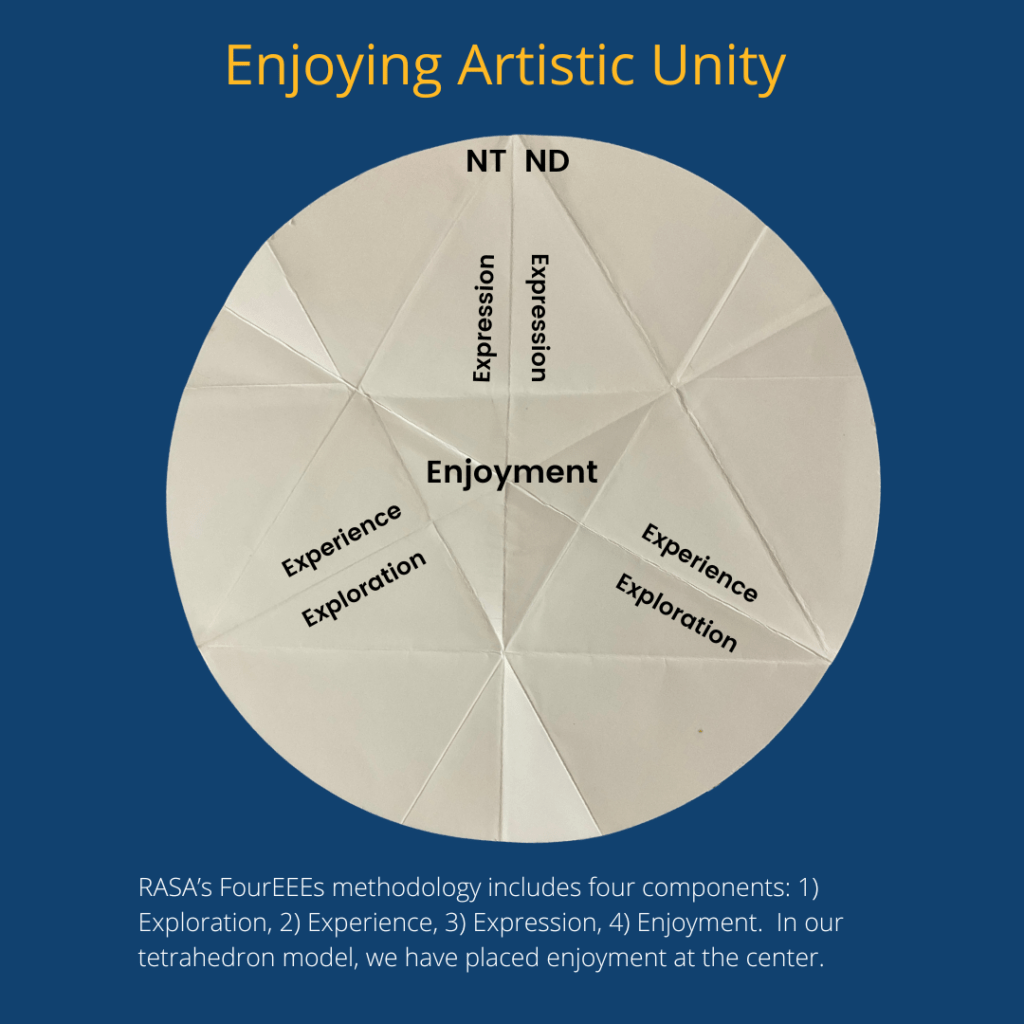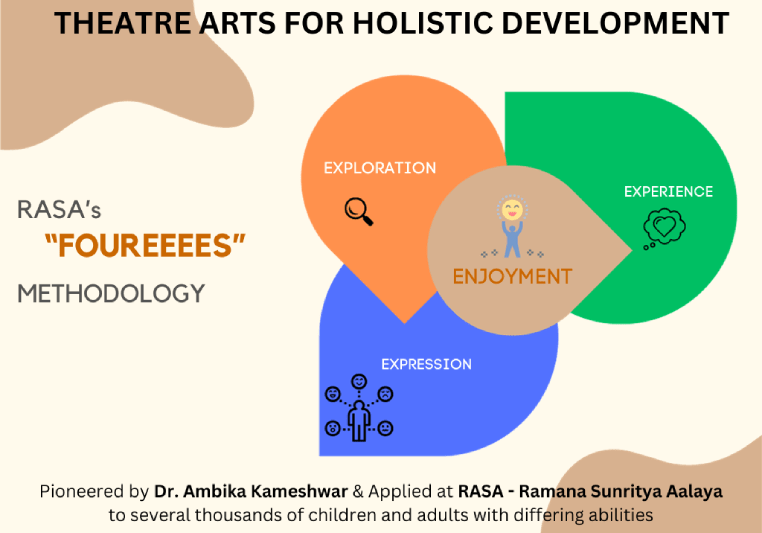On December 13, 2023, I attended the of Abilities 4 All Wall of Fame at IIT Madras.
As noted in the video description, “Artabilities 4 All Wall of Fame,” is an inspiring platform dedicated to showcasing the exceptional creativity of artists with disabilities. This event was a celebration of their diverse and unique artworks. See the video of the event below:
https://www.youtube.com/live/YH6lEuNbaUU?si=1geWmRBi6nZTlxsn
In addition to display of art works by artists with different abilities, there was also inclusive music and dance performance. The inclusive dance performance was by the RASA team. There were two solo dances, and two group dances. This event sparked thinking about inclusion and related topics.
In this post, I will present a visual and tactile model of RASA’s approach using a unique method of folding circles (Wholemovement). I will also share some of my experiences at the event. Since the purpose of my blog is to present a neurodivergent perspective, I hope readers of the blog will get a better understanding of how I learn. I can learn complex ideas and think about them. However, I need visual tools to better organize my thinking. Visual thinking is an area where neurodivergent individuals can contribute to organizations because they may have practiced it regularly. I will also share my experiences at the Abilities 4 All Wall of Fame event.
I. Enjoying artistic unity: Building a Visual Model
One of the dignitaries who presented at the event was Dr. Ambika Kameshwar (Founder and Director of Ramana Sunritya Aalaya). RASA – Ramana Sunritya Aalaya was founded in 1989 by Dr. Ambika Kameshwar with the vision to empower one and all, through the Theatre Arts experience.
According to Dr. Ambika Kameshwar “The word ‘inclusion’ suggests something or someone was left out before. In the TAHD way, we focus on enjoying the artistic unity rather than excluding others, making deliberate inclusion efforts unnecessary.”
As I understand it, Dr. Ambika is saying that we should not be talking about exclusion and inclusion, rather everyone is together.
In this article, I will present a visual model to explore Dr. Ambika’s quote. As a neurodivergent individual, I prefer learning with visual and tactile tools. One tool that I use is the folded circle. Even though many neurodivergent (ND) individuals seek visual tools, visualizations can also benefit neurotypical (NT) individuals.
My mother (Dr. Dasaratha Rama) had to explore many visual tools to teach me. We have over 20 years of experience with visual tools. Based on this experience, we have built a tetrahedron model of RASA’s approach. Folded circles are a unique way of visualization where we do not model by putting bits and pieces together. Rather, everything is together as suggested in Dr. Ambika’s quote.
The circle represents unity.
To build the model, I folded the circle into half. When I fold the circle into two, the circle is divided into two halves. One side represents neurodivergent (ND) individuals and the other side represents neurotypical (NT). NTs and NDs are together. No one is excluded. We do not have to include people later. Thus, the first fold itself captures Dr. Ambika’s message.
Then, I divide the circle into six parts (three diameters). From these three diameters, I can create an equilateral triangle, and then a tetrahedron. At every stage, all the parts stay together.
Another benefit of visualizations is that we can add more ideas and yet keep it understandable. We have added the four Es (exploration, experience, enjoyment, expression) to the basic circle model. RASA uses the four Es methodology and the four Es are the way they achieve artistic unity.

Enjoyment
As seen in the picture, there is a small triangle in the centre. We label this enjoyment to represent the idea that TAHD is about enjoying experiences together.
Exploration and experience
The bottom triangle has exploration (trying something new) and experience (being immersed in a more familiar activity). Both NDs and NTs are engaged in explorations and experiences. However, they may learn and communicate differently, so their explorations and experiences might be different.
Expression
The final component is expression. After initial exploration and experience. Individuals engage in creative expression. Again, NDs and NTs can express themselves differently.
RMCL Annual Day
I am preparing for my annual day performance for Ramana Maharshi Centre for Learning (RMCL), an organisation in Bangalore where I attend classes to explore Sri Ramana’s life and teachings through artistic expressions. I will describe the experience using the model shown above. There are many ways in which TAHD ingredients can be combined while achieving artistic unity. My annual day experience can be explained using the four Es:
• Exploration
Initially, I explore new songs with Ujwal anna in my individual class. I try the annual day song on my own, but then I also participate in the group class.
• Experience
As I continue learning the song, I continue learning in my individual lessons. I immerse myself in practice so I can memorize. I continue attending the online group class.
• Enjoyment
I enjoy all my individual and group experiences.
• Expression
Expression is our final performance at the annual day. This is the stage where the group component will be the most important.
Thus, I am able to experience artistic unity while learning in a way that works for me.
In February, I will participate in RASA Day. In a later blog post, I will share another experience of artistic unity using the same model.
II. Bridging the Neuro-divide
NTs and NDs may enjoy similar experiences. For example, I enjoyed performing, enjoyed watching performances, and enjoyed interacting with others at the event. However, NDs may also enjoy different things than NTs. Right from the time when I was a young child, I was interested in tall buildings and elevators. I am still fascinated by tall buildings and high floors.
I was therefore pleasantly surprised that the event was on the eighth floor. We went up by the lift to the eighth floor and went to the hall. When I went in the elevators, I was surprised that all the floors were listed on the elevator panel, but the elevator only stopped on certain floors. The tall building and elevator increased my enjoyment of the event. These details may not interest neurotypicals, but NDs should also be encouraged to talk about their unique interests. I felt comfortable talking about elevators to Dr. Ambika and Dr. Vaishnavi.
Read a funny story about what happened when I stayed on a high floor here: https://specialsaathi.com/2022/11/05/30th-floor-30th-floor/
I have been blogging for Special Saathi for over a year. They have many conversations on bridging the neuro-divide.
While the circle shows that the NDs and NTs are together, communication can be a challenge because of the differences. When I was growing up, it was assumed that NDs would make efforts to fit into the NT world. Bridging the neuro-divide means both groups work together and respect each other.
III. TAHD impacts
TAHD creates opportunities to interact with NTs and NDs, but I do not have any pressure to act exactly like NTs. Now, people recognize that masking to fit in with NTs causes a lot of stress to NDs. Enjoying artistic unity means we can be who we are and participate in activities with different kinds of people.
See a video by my mother on TAHD as a neuro-affirming practice that creates opportunities for neurodivergent children and adults to enjoy learning in their own way.
https://youtu.be/epRHN6ni7cI?si=5v9VopFWRpe7npr6
I learn many skills such as movement and communication through TAHD, but learning skills is not enough, having access to an environment designed for enjoying artistic unity is extremely important. I am grateful to Dr. Ambika Kameshwar for creating such an environment.
Tags: Neurodiversity, neuro-affirming, TAHD, artistic unity, fourEEEEs, exploration, experience, enjoyment, expression, and inclusion

7 Responses
Ananth, thank you for this detailed and comprehensive post!
I love the way you presented the visual model of the 4 E’s. You are absolutely right, visual learning not just helps NDs but also NTs to understand better.
I also loved the way you weaved in your unique experiences throughout the post and reminded the readers that we perceive the world in our own way. And they are all valid experiences. This thought itself eliminates the disparities we create and exclude someone and later on work
on inclusion.
You have had an amazing journey and your mother,Dr Rama, has a large role to play in this. I thank you both for sharing your lived experiences with the parents and allies of ND community. I truly hope you reach a large audience because this post should be read by many!
Hello Ananth, I loved the way you have comprehensively explained inclusion and how you have used visualization tools to explain the same. Great write up.
Dear Ananth,
Your reflection of how folding the circle supports the many things you experience, navigate and express brings me SO MUCH delight.
My name is Ashley Smith. I am Bradford Hansen-Smith’s daughter. I fold circles too – and share this process with others. This activity supports how I understand and experience life too. I may be labeled NT however there are many times I feel NT on the inside.
The circle offers a way to access beautiful expression as it is unique to each of us and I am grateful for yours. Thankyou.
Thank you Ms. Smith for reading my blog and responding. I enjoy folding circles and hope to share more folded creations in my blog.
Ananth, it is a joy to see you are progressing with dancing and and now blogging. There is much to explore in the arts, and nature, and how beauty can elevate people’s experience towards greater acceptance of differences that must eventually find context in unity. RASA is on time for what the world needs. The beauty of humanity is in unity with what is good and true in all things.
You tell the 30th Floor story very well. I think many people can relate to this experience. Maybe you will tell us more of your stories in future blogs.
Thank you Ms. Anantha. I appreciate your feedback on visualization. I plan to build it further in future posts.
Thank you Ms. Bindhu for your detailed reply to my post. Appreciate your feedback on visualization. I plan to develop this further.